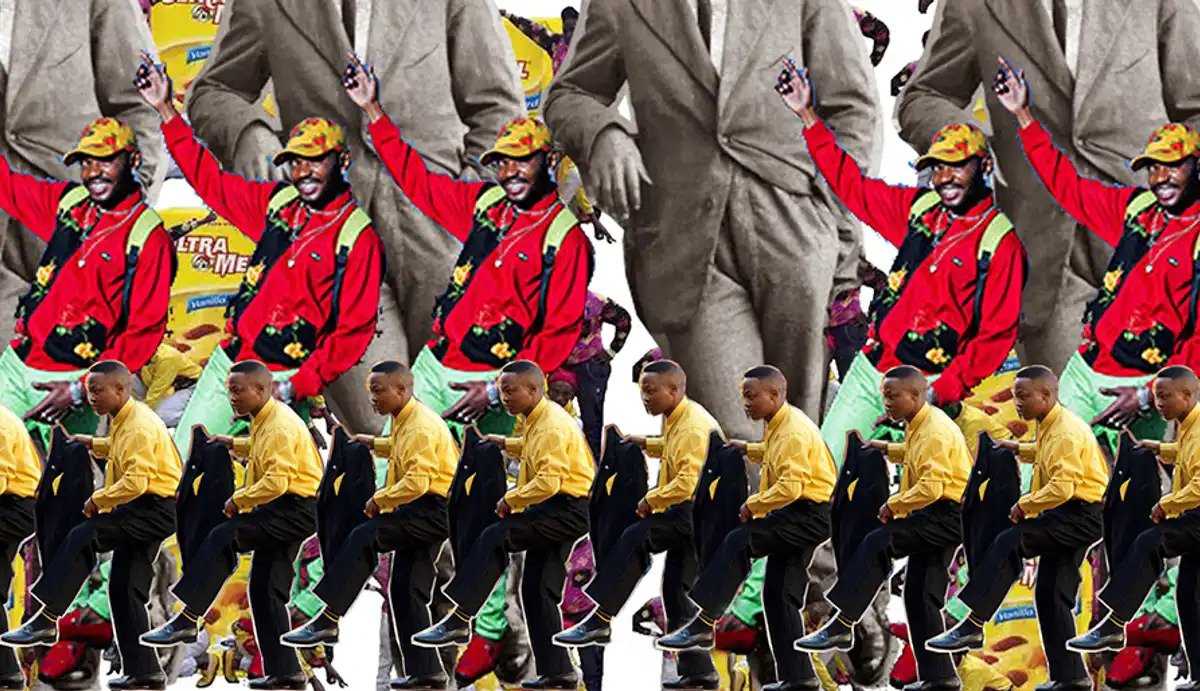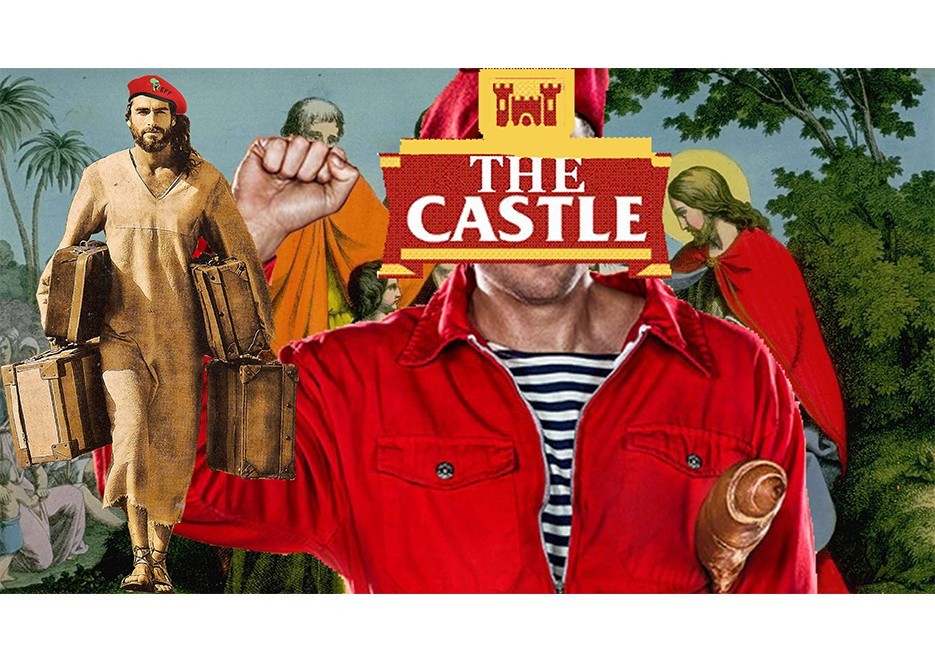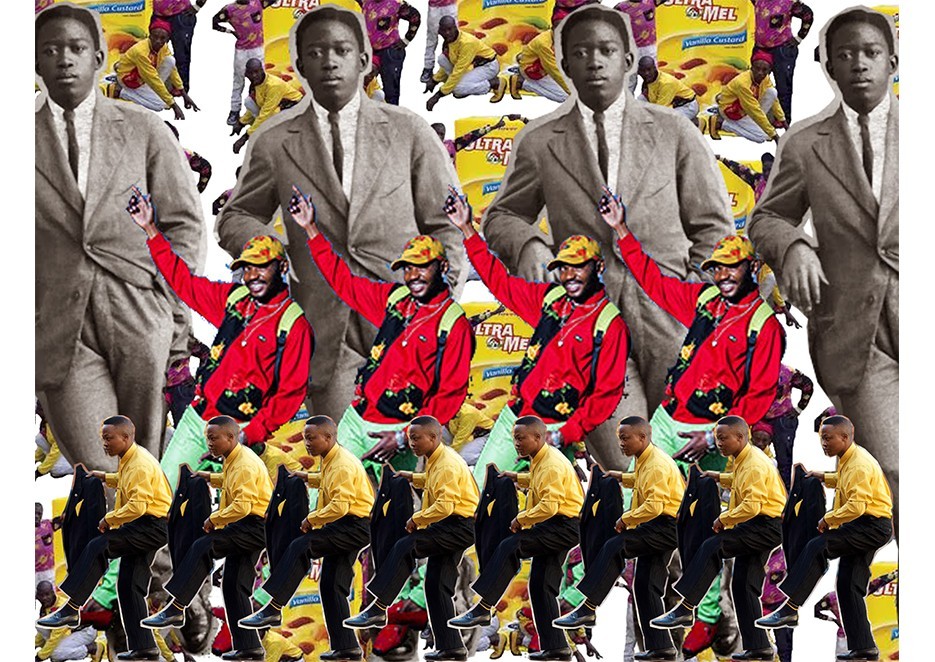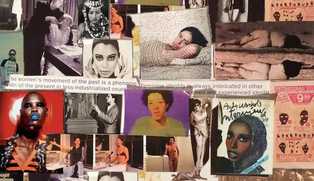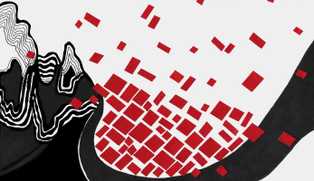South African artist Tiger Maremela is the creator of the multimedia series roygbiv. Using Instagram, collage, collections of videos, images and music they interrogate the utopic myth of the ‘Rainbow Nation’, throwing into question the idea of South Africa as a post-apartheid, non-sexist, trans inclusive, post-racial, unified society. Their playful aesthetic seeks to express a new kind of decolonial consciousness. Tiger takes notions we are familiar with, such as the politics of blackness, health and sports, masc(k)ulinity, colonialism and capitalism, and challenges our perceptions and understandings of these concepts. Having watched their videos on repeat (which we are sure you will do too), Skin Deep reached out to Tiger to talk about their work – past, present and future. Here is our conversation.
*
Skin Deep: In the world you have constructed in your work, you use a lot of colour and things that look ‘kitsch’; your work is very playful, but there seems to be a sense of irony in this aesthetic. Can you elaborate on how you configure play and playfulness within your work? Tiger Maremela: The use of colour derives from the name of the project and the largest influencer of the project. South Africa’s “Rainbow Nation” nation-building project seeks to celebrate the country’s diversity and various cultures and often alludes to a post-racial society. The aesthetic of playfulness came from wanting to unpack this supposed rainbow and show the black/white divide that is clearly still apparent in society. The kitsch look isn’t one that was I was striving for – all the content was sourced online and some footage was shot on camera phones, or on cameras with old technologies. This is what provided that kitsch look. SD: How did you intend for your roygbiv series to be viewed? TM: The intention with roygbiv was for it to be viewed on a screen (desktop/tablet/mobile), and to be viewed multiple times, because that’s how I feel one can fully begin to understand the project. The use of the multiscreen is prevalent in the ways in which I’ve chosen to create the video, but I also wanted to link that to how we currently use multiscreens (ie. watching the news on the TV, looking at your Twitter TL on your smartphone, and shopping online on your tablet – sometimes all the same time). I wanted to present this multiscreen/multidevice relationship in a very overwhelming and dense way.
SD: Why did you choose this particular medium – a multimedia visual series – to interrogate notions such as the politics of blackness, colonialism, capitalism, sports, health in black communities, varying forms of masc(k)ulinity, white supremacy, land reform and redistribution? Is there a link to be made between the fragmentation of the medium and the notions you are challenging? TM: Over the last 3 or 4 years, I’ve been experimenting with different mediums. This has ranged from writing (poetry and journalism) photography, videography, digital collage and fooling around with sound design software. I then pulled all these interests together to produce the project. I had been experimenting with collage murals on Instagram and had begun thinking of how I could present these in video form. What I have really enjoyed with collage was how it allows you to use all these pre-existing elements – each with their own meanings, connotations, and ways in which they are coded/decoded – and reconfigure them to produce something new (that can still have the same contextual narrative, or not.) Prior to producing the collage I had done research on the issues that I interrogate in the series, and had been really interested in the concept of decollage and how it links to post-apartheid South Africa – where apartheid and neocolonial architects have created the Rainbow Nation by cutting, tearing away or removing, pieces of an original image. And here the original image could relate to Africa before colonialism, or before the migrant labour system, or before forced removals. The original image is any site (literal/metaphorical/imagined) that exists, or strives to exist, outside of white supremacy’s gaze. I wanted to reflect on how South Africa today is the result of people’s histories, identities, cultures and trajectories having been cut/removed/torn apart/disrupted. What I think is also tricky about collage is the risk of perpetuating the violence of stereotypes through imagery. Being black, queer, trans and young means that I have to be aware of how images can and have been used to oppress people and I should not run the risk of repeating these same kinds of colonial narratives. SD: You use what one might call ‘screens’ or visual planes that are clearly distinct from each other. This complicates the depth of the videos as it draws attention to the surface of the work, but also gives the impression that there’s something underneath or behind, an element we can’t see. These blind spots are fascinating, and raise the question of what necessarily gets hidden in collage. Do you think about the significance, formal or otherwise, of what gets blocked out? TM: Colonialism has disrupted so many narratives that it has complicated the ways in which in which we can imagine ourselves. I was drawn to the ideas of multiplicity, multiscreens and double consciousness when creating these various planes. The idea was to imitate the experience of having an identity that is on the margins, or in a liminal spaces, and the kinds of tensions that this experience can bring about. I was interested in the idea of double consciousness being a burden and a blessing, an exhausting experience that still pushes you towards unlearning, reimaging, and thinking outside of yourself. The use of blind spots was a deliberate one – the project is not meant to be watched once. And I think this goes against the norm on the internet where things go viral and then we forget about it. The objective is for people to watch it as many times as possible, over different points in time, having become and created different parts of ourselves. History as we know it is very calculated, so is the representation of marginalized identities, or the archive of what exactly happened for us to inherit post-apartheid South Africa. And so even when putting this series together, I was aware of what I was hiding/blocking/leaving out. What I am expecting is that everybody who watches the series will have a different, subjective way of uncovering what has been hidden. SD: Masc(k)ulinity is a predominant theme in work, as is sports. The Springboks and Bafana Bafana in particular have a very obvious presence in roygbiv. The connection between sports and masc(k)ulinity is a fairly obvious one to make, but it feels like your work is saying a lot more than that. Do you see your work as a commentary on the interplay between national sports, and by extension national pride, and masc(k)ulinity? TM: Since long before South Africa won the 1995 Rugby World Cup, or when we hosted the 2010 FIFA World Cup, sports have been used as an integral part of the nation-building project and have been used to “unite” the country. The link between masculinity and sports is apparent, but I wanted to look at how they also link to race, gender and capitalism. For example, in the context of post-apartheid South Africa, rugby is still a predominantly white sport and soccer is a predominantly black sport. Men’s soccer still garners more (capital/social/structural) support than women’s soccer. I think all of this links strongly to a post-apartheid state that continues to promote heteronormativity, has a suspicion of femininity, and a reliance on white monopoly capital in order to exist. SD: roygbiv features a photo series by photographer Jim Naughten, who dressed the Herero people of Namibia in Victorian clothing and photographed them in the desert. The series, called ‘Conflict and Costume,’ is in many ways a commentary on performance and coloniality. The decision to photograph the Herero people in particular is quite a political choice. In his book ‘Good Muslim, Bad Muslim’, Mamdani argues that the Herero people were actually the original victims of the first genocide of the 20th century, not the Jews; the Germans practiced the tactics that they would later use on the Jews on the Herero people during the Namaqua Genocide. All of this is to say, your work goes beyond dealing with post-Apartheid South Africa, and deals with the broader history of conflict in Southern Africa. Why did you choose to use the photo of a woman from Naughten’s series? TM: Jim Naughten’s work definitely inspired parts of the work in terms of aesthetics, technique and the kinds of commentary he was making with the work. The relationship between colonialism and performance is still apparent, for example in the ways in which black-subcultures are perceived and critiqued. I observed izikhothane, and the Sapeurs, and wanted to celebrate their aesthetic integrity rather than all the negative headlines that we have heard. I wanted to racialize the ways in which many black subcultures in the “Third World” are observed – whiteness has led us to be believe that poverty and modesty are what black people are destined for. I wanted to complicate this form of racism by celebrating groups of people that are showing agency in their consumption of goods. I particularly enjoy this “reappropriation” of clothing and Western fashion, especially in relation to the Herero women who pride themselves in these clothes that many would consider an inheritance of colonialism. Throughout the series I make links to other countries and regions on the continent. South Africa does not exist in isolation, and often our histories and tragedies overlap. SD: Black womanhood is another theme that your work complicates. In part 5 of roygbiv in particular, you pay tribute to black female icons that have not been given due acknowledgment. In some ways, through your work, they are being reinstated to their rightful place in history. But, of course, it is retroactive reinstatement. What does this tendency – to write the narratives of women into history after the fact – say about the way in which we talk about history? TM: I think often when people are “retroactively reinstated” into history it isn’t considered to be as legitimate as the previous version of history. But I think the writing of narratives of black women is an act of decolonization. It is an act of saying that white men aren’t the only ones that have done important work. The history of Africa was authored by people viewing the continent from a very racist/sexist/fetishized lens, and so it is always necessary to write these people back into a history that has erased them. These retroactive reinstatements are a way of showing that history erased various people and identities, and remembering that many of the political movements that have done the work of liberating masses would never existed without black women. SD: In part 5 you also use images of the ‘Fees Must Fall’ movement in South Africa. What do you think the role of creative work by artists like yourself is in the student led political movement in South Africa at this time, and more broadly in the challenge to coloniality? TM: I feel that my work has links between the #MustFall movements and ‘fallism’ as an ideology in that they both strive for decolonization. Thuli Gamedze wrote about decolonization as an art practice and the role of art in activism (ie. art activism): “We can expand art to the extent that when we talk about art, we are speaking of a conscious, creative approach that is in response to images, and through response, creates its own images. Art thinking, art behaving, art conversing, art writing – these are activisms of art production that make use of our innate creativity in decolonizing and re-imagining our space.” Challenging coloniality, especially in the art scene, would require a dismantling, a reimagining, an inclusive politic, and a consciousness. SD: Our next issue of Skin Deep is entitled Imagining 2043. Your work is arguably futuristic. How would you respond to that theme? TM: I’m still deciding how I feel about my work being, or being considered to be, futuristic. In the context of afro-futurism, there is this notion that seeks to conflate the African continent and its creativity into a single monolithic entity. Afro-futurism imagines a homogenous future for Africa, and I’m afraid that it still maintains a problematic fetishized/exoticised lens. Afro-futurism almost ignores the context-specific issues and tensions that exist all throughout in Africa. Africa is currently experiencing several futures, presents and pasts. The second issue I have with the work being seen as futuristic is that one of the ideas that guided the creative process of this project was the interest in how media on the internet can be considered as archival tools. So this series is a creative and subjective way for a black, queer, and trans young person in South Africa to archive what has happened in post-apartheid South Africa. The intention of the series was to focus on what has happened, what is happening, and a challenge to the audience to think of the various ways in which we could become. SD: In part 6 you address the critical issues of depression and suicide. Then in part 7 you observe the impact of modernisation on Indigenous communities in South Africa. Do you think that these mental health issues are in some ways the product of rapid capitalist development? Because you note that there has been a rise in the number of South African men that report being absent from work due to stress and work related anxiety. TM: Part 6 was inspired by my own experiences but speaks to a larger context. In 2015 I was studying at the University currently known as Rhodes, when #_MustFall movements began to gain wider mainstream visibility. It was also in that year when the Black Students Movement at the University currently known as Rhodes began organizing and mobilizing for several issues relating to student accommodation and the changing of the University’s name among many others. One of the demonstrations that occurred led to a 6-week-long occupation of one of the most important spaces in the University – the Council Chambers, where University management and Senate met to discuss the running of the University. During the course of the occupation, armed police officers were called in on peaceful black students, and black students were constantly antagonized by white management. For 6 weeks, a small group of predominantly black students and academics put their bodies, mental health, education and employment on the line. Following the 6-week occupation, #FeesMustFall happened and these same students took part in organizing, mobilizing, and demonstrating alongside other students nationwide. While this work of organizing, demonstrating, and attempting to dismantle the kyriarchy are all important and necessary, what has not become part of the conversation is how this has affected the mental health of the students that are involved in such important work. What part 6 speaks to is the effect of #_MustFall and apartheid on the mental health of students participating in such intense spaces. I really appreciate how you noticed the links between the two videos, part 6 on mental health and part 7 on modernization and capitalist development. While the latter was looking at the effects of modernization on Indigenous communities in Ethiopia, I wanted to look especially at the ways in which it affects the livelihoods of these communities. I wanted to also look at the fetishization of and obsession with indigenous communities by the West (I suppose it feeds their ideas of the noble savage?) The link between these videos is subtle, but looks at the ways in which modernization and capitalism affect mental health. The pressure to maintain normative capitalist standards is hard on black people. It is necessary to look at the racialized and gendered implications of capitalism – it seeks to maintain white supremacy and heteronormativity. SD: Can you tell us about the 8th and final part of the roygbiv series? TM: With part 8 I wanted to look at the placement of masculinity as an important part of South Africa’s nation-building strategies. In this video various idealized masculinities are compared and contrasted to non-hegemonic masculinities. I juxtaposed white supremacy’s obsession with black male sexuality with South Africa’s consumption and fascination with black male sexuality. The symbolic annihilation of black queer/transgender identities in South African mainstream media is contrasted with the strides that the media has taken with regards to representing black queer/transgender men and people (albeit with issues). In the context of South Africa, we’ve had the Civil Union act since 2006 and our constitution guarantees equal protection before the law to all citizens regardless of sexual orientation – but I think this has made the nation complacent in doing the work of gender justice. As a nation, we are so pleased with the cake from same-sex marriages that we are not having conversations, and most importantly, doing the work of providing adequate shelter and medical care to queer and trans people, ensuring that trans people are protected and safe, tackling gender-based violence, creating spaces that are queer and trans inclusive, doing the work of degendering/decisgendering society. This video was heavily inspired by the many black queer and trans people who are finding the courage to become themselves in a society that actively seeks to erase them. SD: What projects are you working on at the moment? TM: I’m currently working on a new body of work under the title F5 (alt. ZA). It is a project that looks at the decolonization of the internet, its aesthetics, its ability to be used as a tool to address social justice and overall the internet as a site of struggle for systemically and systematically marginalized groups of people. The work looks at issues such as self-presentation/curation online, digital discrimination, social media as an archive of the self, the possibility of URL safe spaces, a disruption of locality and time through the internet – all from the perspective of black, queer, trans internet users. The project includes video-based work, photography, and performance. Besides making art, I work at a digital marketing agency. I also recently gave a talk on the state of digital art in South Africa, and I’m really looking forward to giving more talks about the internet, cyber/art activism, and the digital as it relates to the political. Videos and stills from ‘roygbiv – for black boys,’ by Tiger Maremela. Skin Deep will be exhibiting work by Tiger Maremela at the Skin Deep 6×60 event on the 17th April 2016 in London. Get tickets here.


